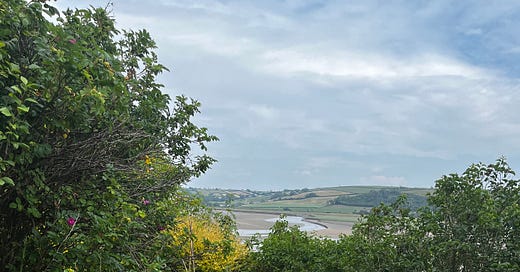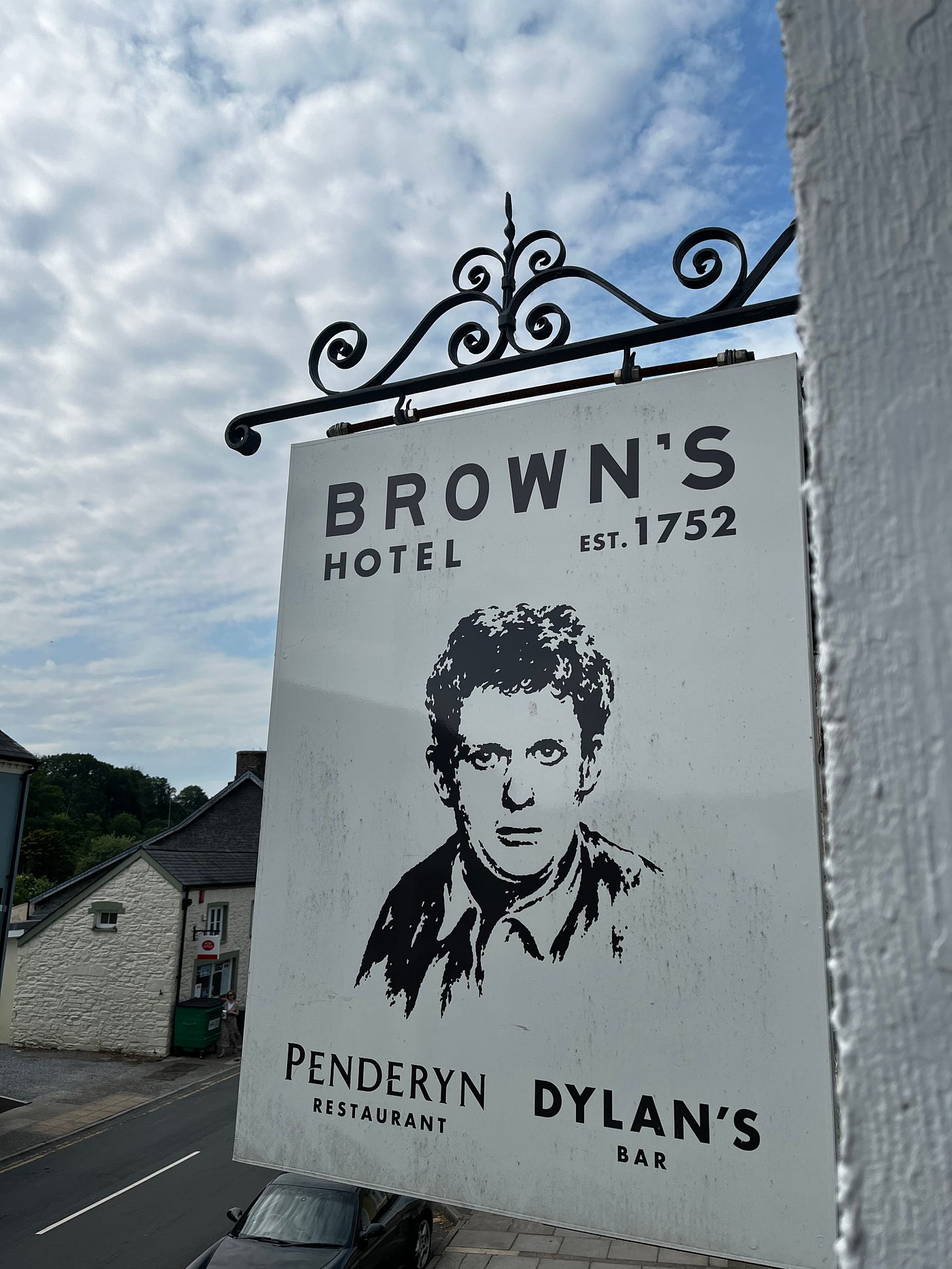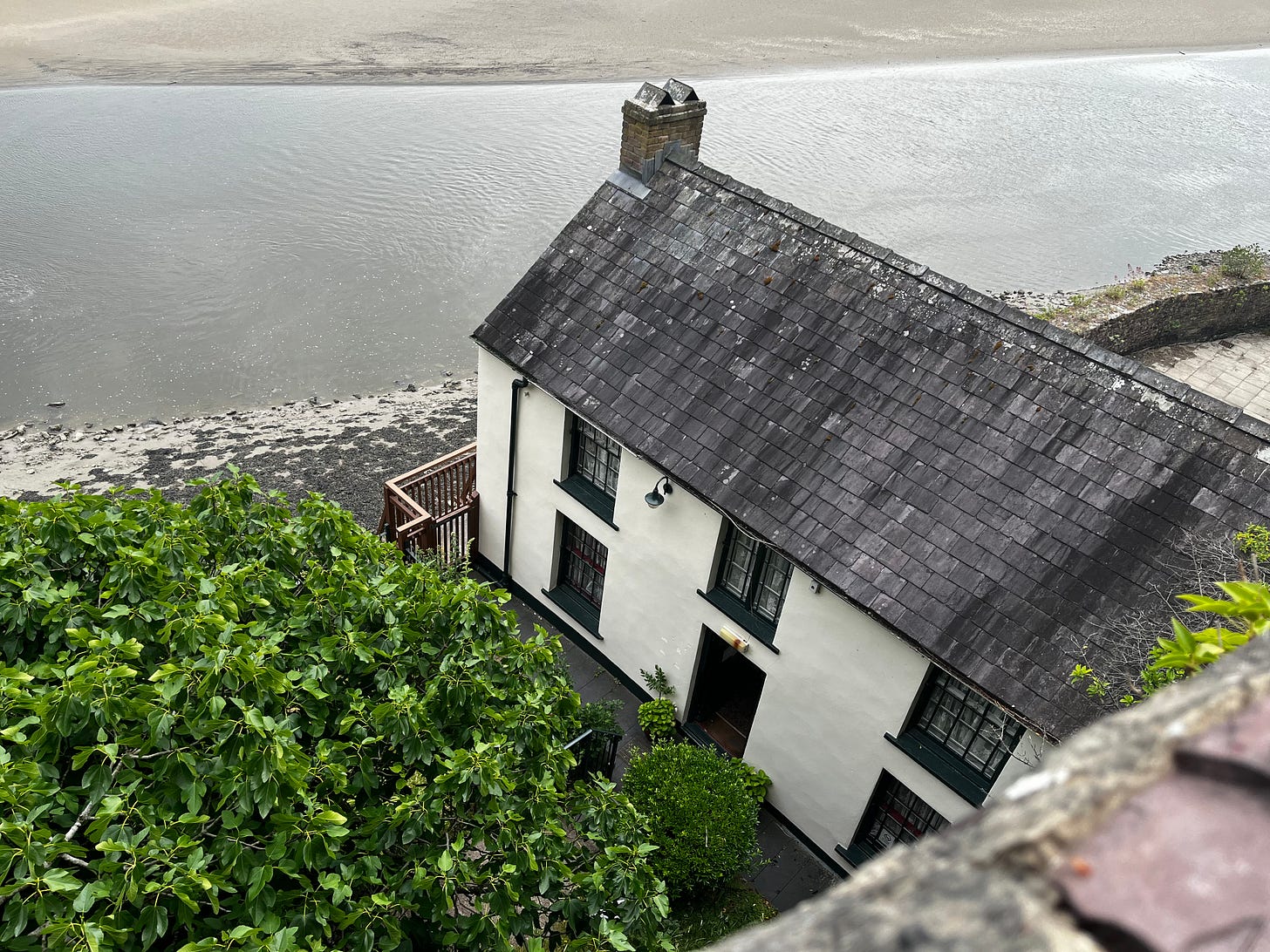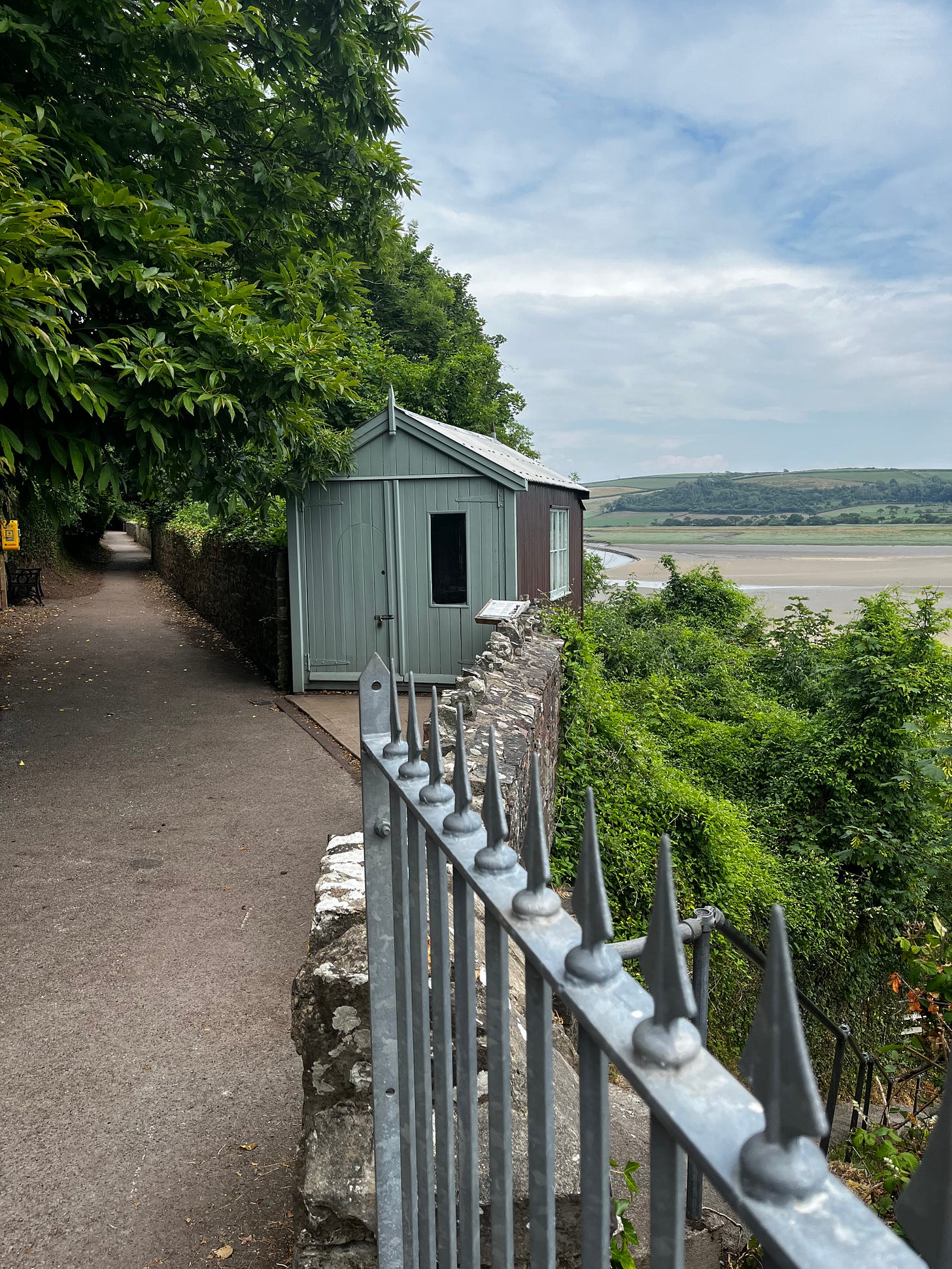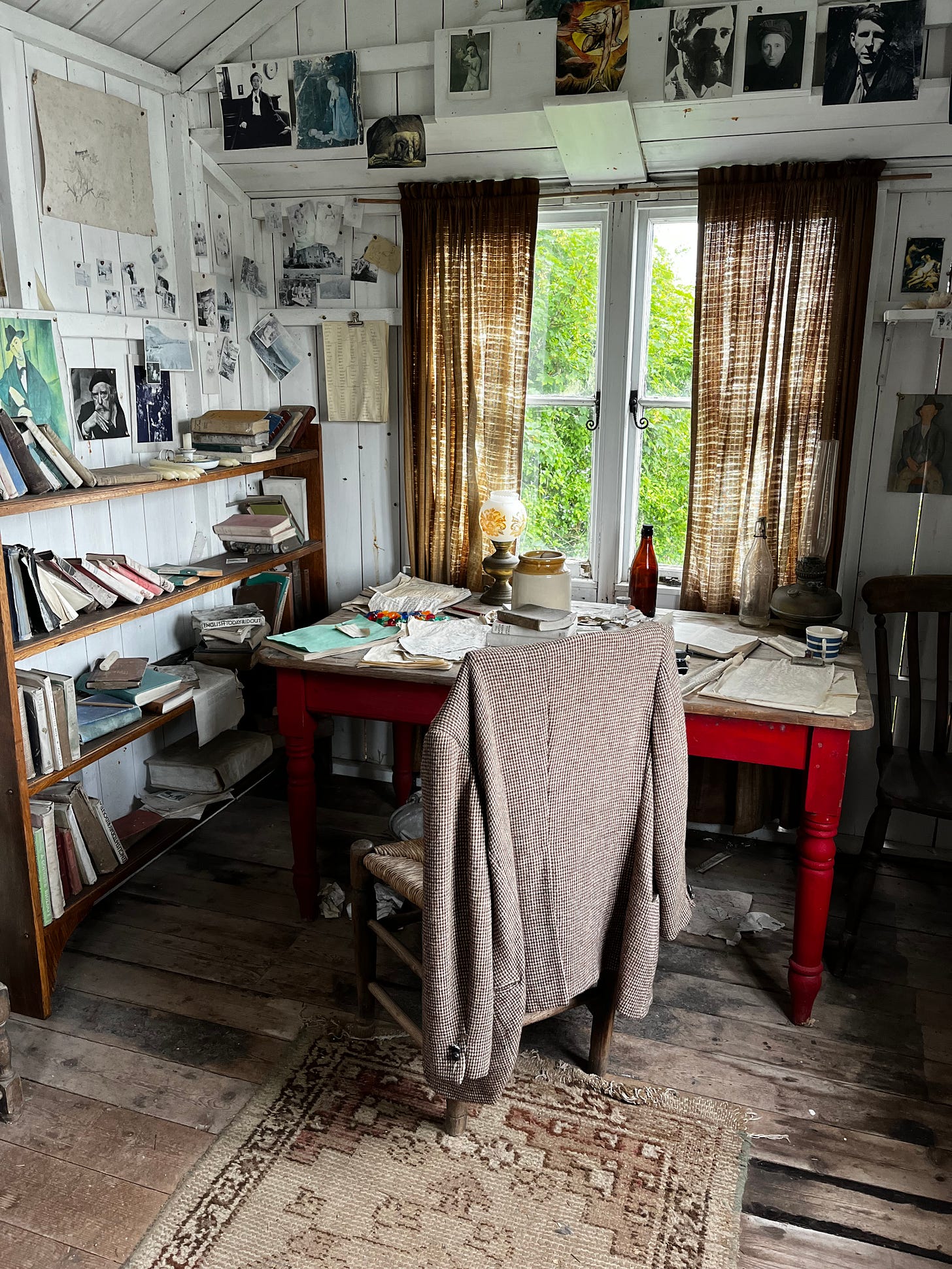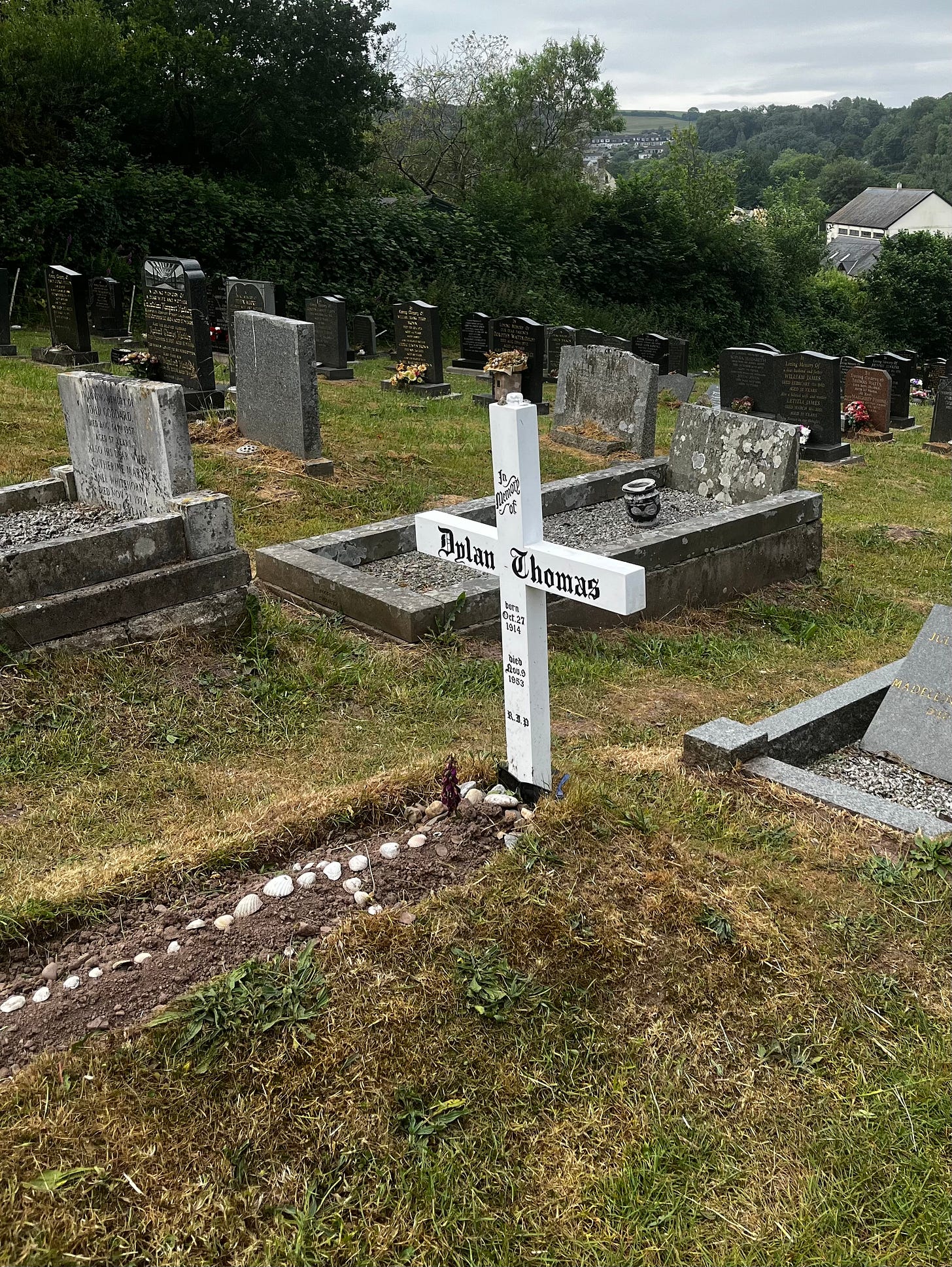Black-faced sheep stand still in the valley along the Great Western Railway line, filling their bellies with the grass of the English countryside. Some hold onto the hillsides, their tails in the air, gathered together in threes and fours. And near the tracks, a stream runs, and shirtless young boys carry on in a waterfall. This is Western England, a few miles east of Bristol where outside the old village, rows of brown and grey stone homes lean against gardens of red roses.
This is how it is when getting to Portsmouth Harbour on a Sunday in June.
This morning, I left Laugharne. It had been two nights at Brown’s Hotel on King Street, walking distance from the boathouse and writing shed of poet Dylan Thomas, even closer to his burial site in the cemetery at St. Martin’s, a 15th cemetery church. Early in the morning I had walked the cobblestone road to its entrance, under ancient trees, and into the churchyard through a heavy iron gate. Gravestones immediately met me, stones painted in moss, rich green and thriving in the moist sea air. A mourning dove was heard near the church entrance. I saw it as it rested in the high stones near the tall wooden door. And along the winding walk, the names and dates on the graves—some carved in the Brythonic language, British Celtic, spoken even before the Romans occupied this land. The early shadows created a kind of reverence both mystical and magical. I was alone in the audible silence of it all. Somewhere was Dylan’s grave.
Part of this overall journey was to trace ancestry—Irish in County Wexford and Rosslare on the east coast where my father’s mother’s family lived a modest life. To be most specific, the Dugans came from a tiny village—Tagoat, a forgotten crossroads west of the Strand and the sea. There’s a section of the Strand named Doogans Warren. I’m told there’s a connection. England is my mother’s side. Her father was born on the Isle of Wight, his grandfather raised a large family—23 children—and worked as a coachman in the “service of the queen.” Queen Victoria had a residence at the time near Ryde, Osbourne House, a magnificent stately mansion near the sea. I’ve been told John Damp also helped run the home’s stables. All of this plus the trip to Wales, a way to satisfy my literary lust along the way. And so, I came to Laugharne to shake hands with a ghost.
I have long studied Dylan Thomas. First, his connection to Bob Dylan who took his name. Second, his tumultuous life and untimely death, an artist’s quarrel with his genius, you might say. The troubled lives of great creatives have always fascinated me. But it was Thomas’ poetry and his approach to this art that grabbed hold of me later in life and would not relinquish.
“And I am dumb to tell a weather’s wind, how time has ticked a heaven round the stars.” —Dylan Thomas
The rhythms, the musicality, and the beautiful images of his words moved my soul. And even though I was never schooled in great poetry, Thomas spoke to me. And when it came time to find a writing space of my own, I created an 8x10 shed on my property modeled after Dylan’s writing shed—a small space, a desk by the window, and the white-washed wooden-beamed ceiling. My wife encouraged my writing dreams and the shed’s construction. And she, too, accompanied me on this trip abroad, understanding as only loving partners can, that I was on a existential journey of the heart and that this trip could no longer be postponed or discarded.
The arrival in Wales came with unexpected joy and a bit of a political reality check. We arrived at the Cardiff airport late and took a taxi through the dark and the incredibly narrow and winding roads to a coach house where we would stay for one night before driving to Laugharne. The driver drove the lanes fearlessly to a destination he had not previously known. The Fox and Hounds was above a country pub. Luckily when we arrived, the pub door and entrance to the upstairs rooms was still open, and inside, a gathering of locals.
“We’ve been waiting for you,” one said with giddiness, while holding a small black dog in his lap. He had a craggy complexion. His friends—a large woman and a jolly big man—chuckled at his joke.
He and the others nursed their pints around a round table near the door. For many minutes we talked. They were chatty and curious, asking about our journey and our home in Chicago, and laughingly proclaiming that it was impossible that the small Cardiff airport was even open at such an hour and that our room—Number 5—was haunted. They were a welcoming crew and we appreciated their enthusiasm for our visit. The next morning at the car rental, a chatty and affable attendant worried aloud about Trump and how America was going to solve its “problems” with him. “Over here,” he said, “we rely on you. When America is ill, all the other countries get a cold.” He was genuinely concerned. My wife and I assured him we were, too.
But once behind the wheel, the angst of American politics scattered in the wildflowers along the roadside. Stern concentration was needed for driving on tunnel-like lanes behind the tall hedgerows, and to negotiate the drama of left-side travel. Still, we were able to experience the stunning hillsides near Swansea and the tiny tucked-away villages of stone homes and churches. It was clear why Wales, along with Ireland, and soon England could and would always be the lands of poets.
And so, we arrived in Laugharne for two days.
It was after the visit to Thomas’ boathouse along the cliff at the estuary and a private look inside the famous writing shed where I was offered a moment to sit in Dylan’s desk chair, that I realized how deep my affection runs for these artistic places, the holy and sacred spaces, and how my working-class Irish, English, Scottish, and Welsh ancestral ties link me to not only the towns and valleys and the waters, but to a palpable awakening of the heart. In so many ways, this is why I write. The threads are not knotted, but they are unmistakably entwined and floating in the blood of those who came before. The realization coming to me in the graveyard of that centuries-old church as I searched alone for Dylan’s grave.
Turning out of a curve in the church’s stone path, I saw a figure moving over a small bridge or walkway behind the trees. He came with flowing robes, white and black, his long graying hair tied in a ponytail, a full peppered beard. He carried a Bible.
“Beautiful morning,” the Reverend said, smiling as if in a blessing.
“It is,” I said and returned the smile as he continued his walk to the church door.
From where he’d been there was a tall gate, the name St. Martin’s welded in the iron. And on the other side, a hillside where newer graves lined the steep grade in neat rows. Above this, another hill, and among the dozens of stone and granite markers was a single white cross. I walked slowly, being careful not to step on the graves, and found myself before mounded ground where someone had placed seashells in the form of a cross and had left purple foxglove as a gift. I stood silent, reading the marker and lifting my eyes up to the town below. Dylan had died young, but here behind the cover of clouds and a view of Laugharne, he was as old as the hills and the sea. And what he had given us and me was forever.
I stayed there awhile and as I was about to turn and leave, it began to rain, a light mist of tears.
David W. Berner is an award-winning author of several books of fiction and memoir. Www.davidwberner.com

